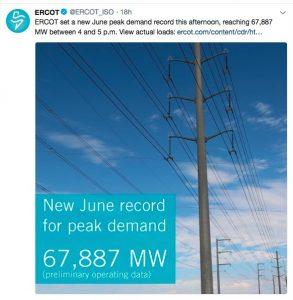
Shop now for a low fixed rate to keep from getting burned!
ERCOT’s new June peak demand record? But It’s Only June 1!
ERCOT’s Twitter posting on June 1 sent an electric shiver through a sweltering Texas:
ERCOT set a new June peak demand record this afternoon, reaching 67,887 MW between 4 and 5 p.m.
Well, technically— demand was 67886.60 MW but you get the point. Texas electricity demand was getting to be in spitting distance of ERCOT’s anticipated peak load forecast of 72,756 MW and that made folks nervous and look fretfully at their air conditioners. And while ERCOT updated it’s available capacity to 78,184 MW on April 31, the amount hasn’t provided much comfort against high Texas energy prices this summer.
ERCOT’s generation shortfall stems partly from the retirement of about 4,500 MW in coal-fired generation and construction delays for roughly 2,100 MW in new resources. This leaves ERCOT’s available capacity with a slim reserve margin of 10.9%. While ERCOT has been making confident noises that it can squeeze through this summer’s tight supply margins using a variety of power management tools, the North American Electric Reliability Corporation (NERC), which oversees the entire continents’ bulk power grids, isn’t convinced ERCOT’s efforts will add up to success, especially in the face of above-average summer heat and a potentially above-average hurricane season.
ERCOT—What Could Possibly Go Wrong?
ERCOT predicts summer generator unit outages due to maintenance and other routine causes to add up to 6.1% or 4,770 MW. NERC cautions that in a worst case scenario, such outages could leave a reserve margin of just 4.8% or 3,753 MW. With only roughly half the reserve margin available, almost any instance of extreme weather and above average heat could knock out the remaining reserves and trigger an Energy Emergency Alert 1 condition.
The tight reserve margins have the potential to wreak havoc during periods of high demand on the wholesale markets where Texas electricity prices can surge to $9,000 per mWh. Not only can the high prices leave consumers with high bills, it can also shut down retailers. On June 1, the Dallas-based retail electric company, Breeze Energy, was shut down by Texas regulators after the company defaulted on its financial obligations. Its customers, mostly in Houston, were automatically switched to other providers’ variable rate plans. It seems likely that other Texas electric companies may face similar actions, especially those companies operating in northern states whose finances were on thin ice during this winter’s bomb cyclone.
How To Shield Yourself From Getting Burned By High Electric Rates
First, if you are in a month-to-month variable rate plan or are considering one or have a plan that is about to end: RUN, DO NOT WALK to https://www.texaselectricityratings.com/electricity-rates and choose a cheap electricity fixed-rate plan with a term that’s long enough to at least get you through summer. The reason is that high electricity demand through the country could help drive up natural gas prices. Because natural gas generates 62% of on-peak capacity in Texas, you’ll want to lock in a good rate now before generator “power-burn” demand begins to lift natural gas prices.
Then, pour yourself a tall, cool drink and bide your time until autumn…
The lure of rising natural gas prices is currently being augured by some analysts as the bait for natural gas producers to over-produce and eventually outpace demand. Some have even voiced concerns about whether there’s even enough storage capacity. If the predicted El Niño that emerges in late summer is a strong one, it would bring warmer temperatures to North America during the 2018-2019 winter. Such an event would likely result in excess natural gas supply and falling prices.
If you recall the El Niño winter of 2015/2016, residential electricity demand decreased by 6%, nationally. Depending how you use energy in winter, that becomes a very nice bit of savings.
